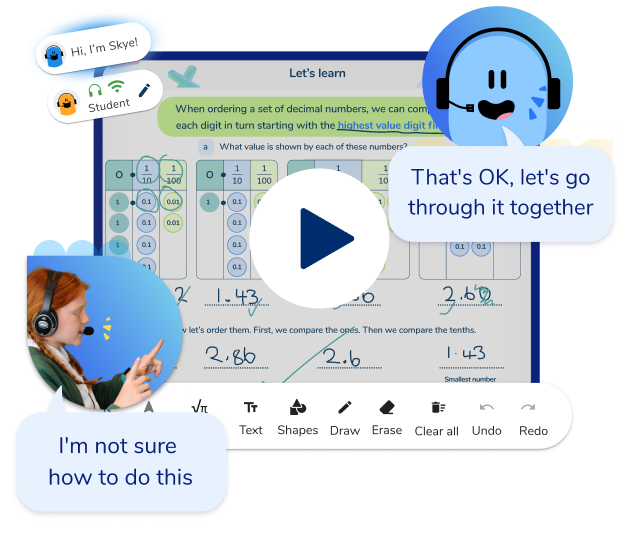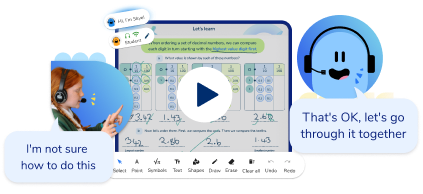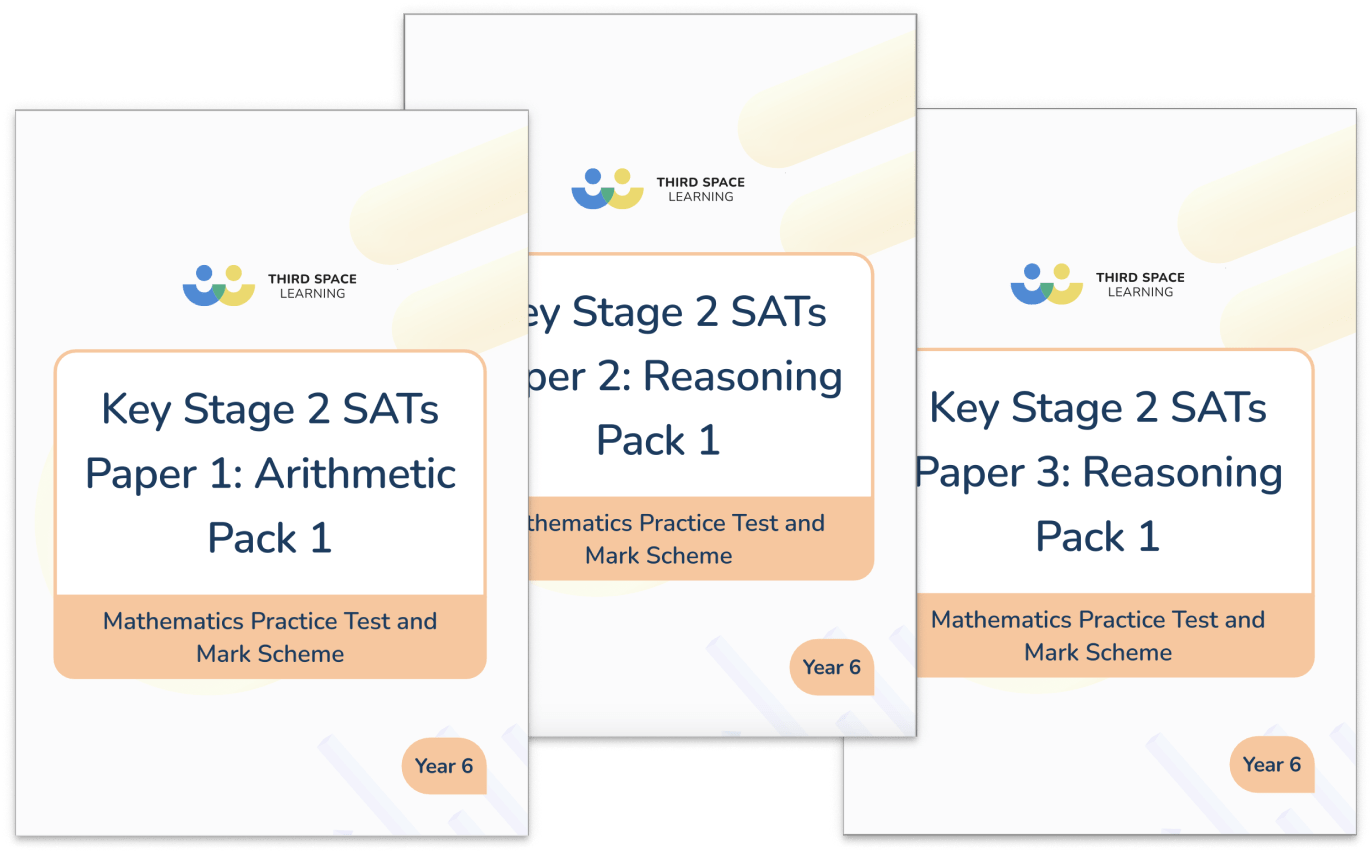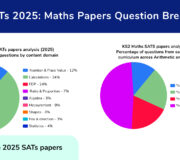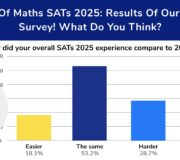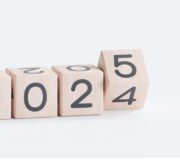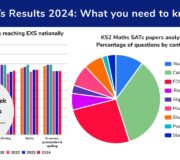Supporting Children In The Classroom To Build Their Stamina In Maths: SATs, COVID-19 And Learning Behaviours
Originally published 22nd March 2022.
Who’d have believed after the May 2019 SATs that it would be almost 3 years before any of our Year 6 classes would be sitting their SATs again?
Primary teacher Sophie Bartlett, reflects on how the events of the past 3 years have affected some of the learning behaviours of Year 6, how this may have an impact on their SATs and how armed with an understanding of this, we can better support pupils.
We then progress to suggesting some practical solutions to the challenges of teaching maths in Year 6, in particular that big one that we’ve all encountered; improving children’s stamina in maths.
Painting a picture of the past 3 years
Let’s begin with a reminder of what primary school maths looked like at a few points since the beginning of the COVID-19 pandemic, through which stamina must be considered.
KS2 Maths SATs Practice Papers
Download this free pack of KS2 maths SATs practice papers to help your Year 6 class prepare for the SATs exams
Download Free Now!Summer 2020: discovering a different kind of maths lesson
Remember summer term 2020? Children would log onto their devices (or open their packs from school) to complete a maths task for the day. The current Year 6 cohort would have been in Year 4, and were about to experience months of disruption to their curriculum.
For the first time, SATs were cancelled, so no longer were Year 6 teachers rushing to cram in the entire primary maths curriculum before May.
However, most children (those not eligible to come into school) would then experience maths lessons rather differently for months to come. Instead of their usual maths lesson routine, they were either learning from a video, a PowerPoint, a worksheet or from their parent/carer at home.
Naturally, this drastically impacted their learning stamina. Even the most motivated of children weren’t going to independently sit and concentrate on some maths for an hour without a teacher, their peers or the general class environment.
One way to reduce the impact of disrupted learning was through schools having some additional one-to-one teaching in place. For example, schools already using Third Space Learning’s online maths tuition were able to continue sessions from home!
Let’s fast forward to the launch of the National Tutoring Programme in November 2020. Although it couldn’t immediately replace the preceding few months, such personalised tutoring became more commonplace for schools and formed part of the bigger picture for children’s learning routines.
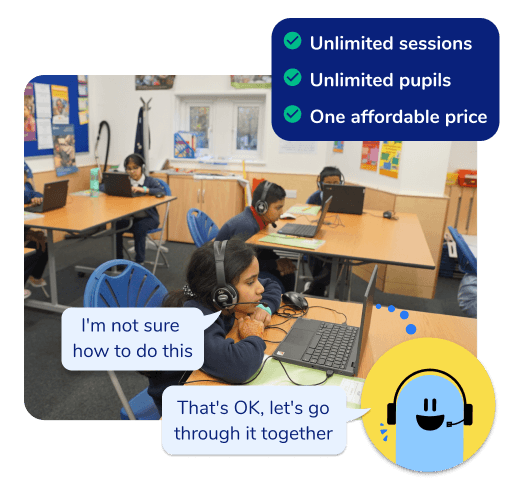
Unlimited primary maths tutoring with Skye, the voice-based AI maths tutor.
Built on the same principles, pedagogy and curriculum as our traditional tutoring, but with more flexibility, reach and lower cost.
Join the schools already helping hundreds of primary pupils nationwide with Skye’s one to one maths tutoring.
Watch Skye in actionSeptember 2020: an interrupted return to ‘formal’ learning
Returning to school in September 2020 meant we could try to build the children’s stamina back up again – and my goodness, did it take a lot of work! Children entering upper KS2 for the first time (the current Year 6s) had missed a chunk of the Year 4 curriculum and had this to catch up on, alongside the usual high demands of Year 5.
They hadn’t experienced ‘formal’ learning for a long time. In addition to the usual pressures of delivering the actual curriculum, we also had to dedicate a lot of time to consolidating the learning behaviours we had previously taken for granted. This was only for the children to return to online learning again a few months later.
Not only was the children’s stamina for learning affected, but also their resilience (and perhaps ours a little too). With so much lost learning, the metaphorical hill we as teachers had to climb seemed insurmountable.
Thank goodness SATs were cancelled again – in fact, for the first time in my career, I felt like I could really, properly, TEACH Year 6 – no ‘cramming’ in sight.
In March 2021, I’d even tweeted this:
Before, it was such a rush to cram everything in and I felt so under pressure to move on to the next maths topic (even if some of the class needed more time) to at least cover everything before SATs. For the rest of the year, I no longer feel a slave to my long term plan! 2/2
— Sophie Bartlett (@_MissieBee) March 2, 2021
And now, here we are. Nearly three years since the last SATs paper and over half a year of schooling missed by the majority of students. The last full year of ‘normal’ education our Year 6s had was in Year 3, and yet in May they are expected to sit national assessments on the whole of the KS2 curriculum.
Sophie Bartlett, Year 6 Teacher
‘Perhaps, like me, you’ve noticed that the children’s stamina is much better than it was in September 2020 – but still not quite where it was pre-Covid’.
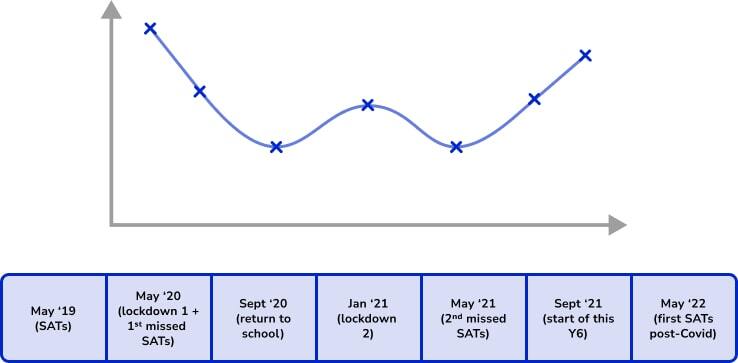
Supporting children’s stamina in maths
This time of year is a tricky one for anyone teaching Year 6. You’ve (probably) still got content left to teach, but equally want to leave enough time to be able to revise. (On that note, I’ve always thought it unfair that we as Year 6 teachers have to fit the same amount of content in as everyone else – plus SATs revision – in nearly 3 months’ less time!)
The stamina required for the SATs arithmetic paper can be particularly challenging for some students. This is especially true for those qualifying for extra time, and therefore have another 7.5 minutes to concentrate for!
Applying methods to different questions
It’s likely that a lot of students know the methods well in isolation, but struggle to interchange between them when different types of maths SATs questions are all mixed together.
In my experience, this mostly happens with the fraction questions.
You’ve taught multiplying fractions using the concrete pictorial abstract (CPA) approach until you’re blue in the face – everyone understands it. Yay!
Then, they suddenly have to answer a multiplying fractions question after a ‘fraction of amount’ question, which is presented with a multiplication symbol (e.g. 4/5 x 20) and they’re thrown. Which method works for which?
Of course, we know that ‘multiply the numerators, multiply the denominators’ can be used for both questions (if we represent 20 as 20/1), but for children less confident in maths, this can become extremely confusing.
Short-burst practice for swapping skills
Regular short-burst practice of swapping between these skills can work wonders.
Identify which questions in particular your class are struggling with and write them on the board each day, only changing the digits. For example:

When faced with a SATs arithmetic paper in future, children could also have a flick through first and circle the questions they know they usually struggle with. Then, they could either focus on these first to ‘get them out the way’, or leave them until the end to give their confidence a boost with the ‘easier’ questions first.
Third Space Learning’s Fluent in Five is a great resource for this sort of short-burst practice. You can explore this daily arithmetic practice for primary school pupils in the Maths Hub.
Building blocks for stamina: where 1:1 interventions come in
If you’re lucky enough to have the time and adult support, there is always the opportunity to provide 1:1 interventions for those struggling the most. This may be for those ‘boundary’ children, or an opportunity to provide a differentiated curriculum for those who cannot access the test at all.
This latter group of children can get easily lost at this time of year when all the focus of year 6 maths revision might seem to be reserved for getting a certain group past the magic ‘100’ in time for May.
Third Space Learning’s online 1:1 maths tuition focuses on the needs of each individual student and moulds the programme to fill the gaps in their maths learning. Third Space Learning’s Year 6 SATs revision programme prepares students for SATs as well as increases their confidence going into the exams. With the same, highly-trained tutor each week students are equipped with the maths knowledge they need to succeed in maths going forward.
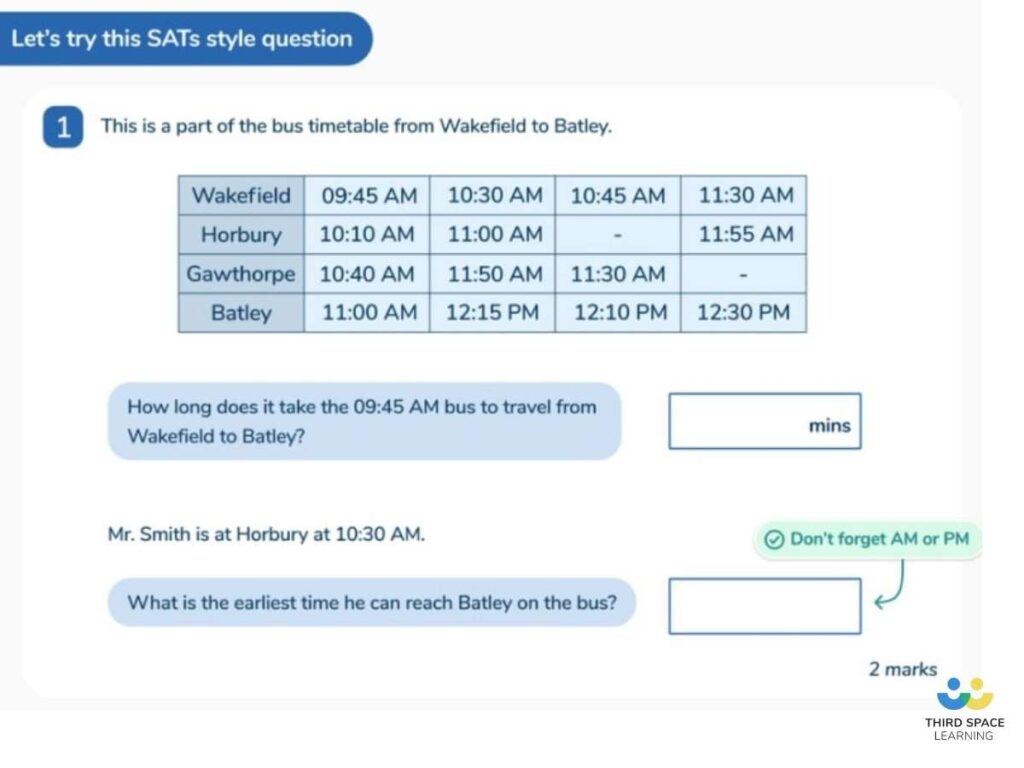
helping students to get familiar with SATs-style questions.
Not neglecting stamina in maths post-SATs
Through this style of maths teaching in Year 6, children will inevitably build up some stamina. However, it’s important that this isn’t then abandoned immediately after test week. It sends the wrong message to children to suddenly change tack with maths lessons, going from intense maths practice pre-SATs, to weeks of “Let’s build a theme park!” post-SATs.
Of course they deserve some reprieve from the build-up to test week, but this needn’t last until the end of the year. There are always going to be areas of maths that they need to practise in order to prepare them for secondary school.
Even if by some miracle there isn’t (if it’s your class that is all scoring 120 on the maths SATs, please let me know how you do it!), the chances are that 10 school weeks after SATs without any ‘proper’ maths lessons aren’t going to do the children any favours.
Harder questions at the back!
We all know that the further through each maths paper the children get, the more difficult the questions are. The mark schemes break each question down by its content domain, which not only indicates the area of maths on which the question is based, but also the year group in which this content is intended to be taught as per the national curriculum.
Analysing 2019 SATs content domains
For example, the content domain reference of Q1 on the 2019 arithmetic paper is 4N3a. This means that this particular question is based on the Year 4 objective of ‘recognise the place value of each digit in a four-digit number’. More information on content domains can be found in the KS2 mathematics test framework.
The graphs below show the spread of content domains in the KS2 SATs Papers 2019.
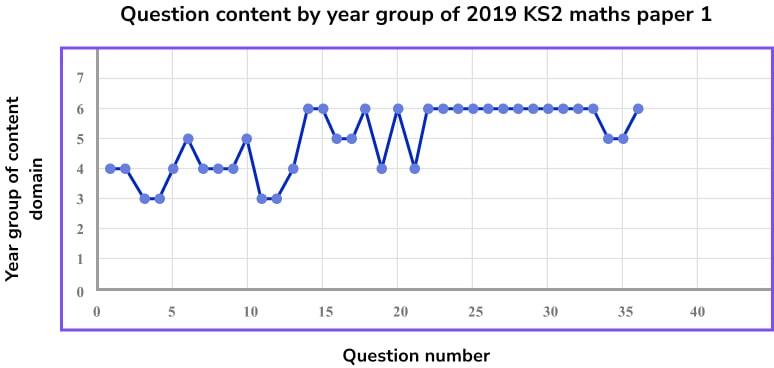
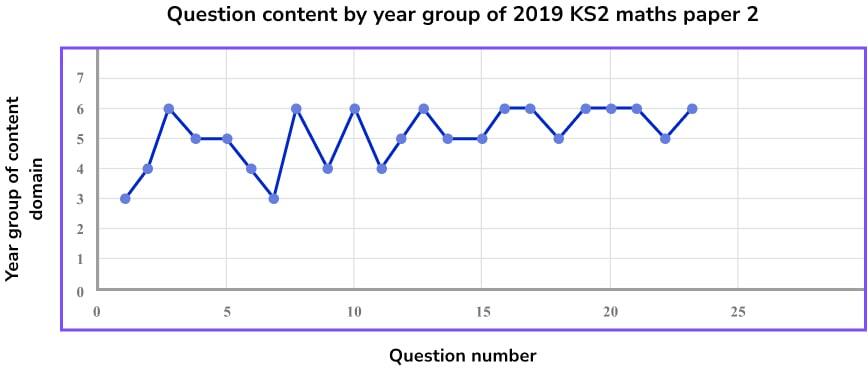
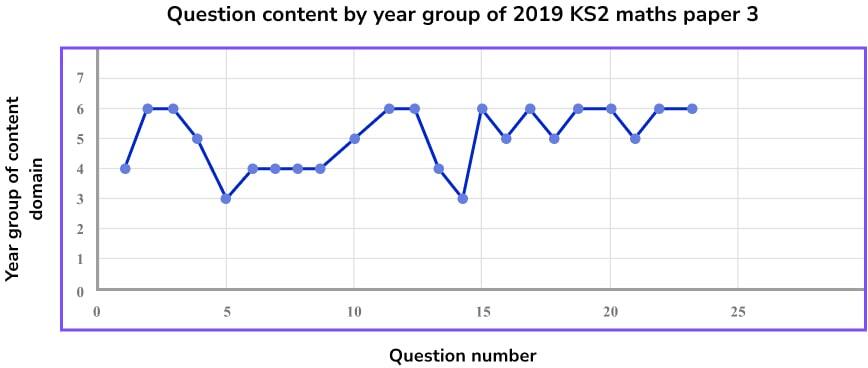
As we can see, the second half of each paper is comprised mostly of content from upper KS2 – particularly Year 6. In contrast, the ‘easier’ questions (those based on Year 3 and 4 content) are almost always found in the first half. We can assume that these are the questions that our struggling mathematicians might have more confidence to answer.
For more information on past KS2 Maths SATs papers, see also:
SATs techniques and time management
When completing a paper, regular time reminders can really help. For the children who know they can challenge themselves to complete the entire paper, I tell them they should reach the ‘staples’ (middle of the test) by 15 minutes. I know half the time is 20 minutes, but the second half is more difficult than the first.
For those who struggle to complete the papers, I tell them to aim for the ‘staples’ by 20-25 minutes. I don’t want them to rush the questions I know they should be able to answer!
‘Pass’ the paper without completing it: a hypothetical scenario
Since 2016-19, the ‘pass’ marks (a raw score which converts to a scaled score of 100) have ranged from 57/100 to 61/110. In the most recent SATs maths paper, the children needed to score 58/110 to reach the expected standard. In theory, this is possible without finishing some of the papers.
Take a situation where a child scores 30/40 on the arithmetic paper – a good score, but perhaps one that doesn’t leave you with much confidence depending on their performance on the reasoning papers.
Breaking down marks, questions and papers
- The child would need to score 28 marks across both reasoning papers in order to pass.
- Taking this as an average of 14 marks on each paper, this equates to reaching Q11 on paper 2 (out of 23 questions) and Q10 on paper 3 (out of 23 questions).
- Out of these first 11 questions on paper 2, eight of them are based on content from years 3-5.
- Similarly on paper 3, eight of the first 10 questions are also based on content from years 3-5.
- If the child were to only complete these first 11 and 10 questions respectively on each paper, and complete them accurately, they would still reach the expected standard.
Of course, life doesn’t quite work like that. Children, like all of us, will make mistakes no matter how ‘easy’ the question. Test conditions can throw children easily!
But this may be reassuring for children to know that if the time limit panics them, they don’t actually need to finish the paper to do well. If they could confidently answer the first half of each reasoning paper, and give the second half their best shot, they’re in for a good chance.
The picture in March 2022
With less than two months to go, we can only do our best.
Everyone has worked incredibly hard, and ultimately, it’s a shame that this effort seems to be condensed into a single number (a scaled score). Luckily, helping the children to improve their resilience and focus in maths will serve a much further purpose than giving them the best chance in the SATs.
Our main goal is to give them the best chance possible with their secondary school maths and beyond!
Read more: Maths SATs 2022
DO YOU HAVE STUDENTS WHO NEED MORE SUPPORT IN MATHS?
Skye – our AI maths tutor built by teachers – gives students personalised one-to-one lessons that address learning gaps and build confidence.
Since 2013 we’ve taught over 2 million hours of maths lessons to more than 170,000 students to help them become fluent, able mathematicians.
Explore our AI maths tutoring or find out about year 6 sats for your school.
